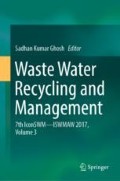Abstract
The physicochemical parameters of most of the tannery industry effluents are not under the CPCB disposal limits. Several techniques are being employed to reduce the level of organic and inorganic pollutants present in this effluent but they are not environment-friendly, low cost, and they produce secondary pollutants like solid waste. Bioremediation has become a more popular methodology for the treatment of environmental pollution nowadays. Six bacterial strains were isolated from a vegetable tannery effluent and were identified as Bacillus, Pseudomonas aeroginosa, Alkaligenes aquatilis, Klebsiella pneumonia, Staphylococcus aereus, and E. coli were employed for the bioremediation process of tannery effluent. The tannery effluent was treated with individual as well as the consortium of these microorganisms. The maximum pollution degradation and higher removal of TDS (64%), COD (76%), and chloride (54%) contents were noticed by the consortium treatment. Out of the pure indigenous strains, Bacillus acted as a more promising bacteria followed by Staphylococcus and Alkaligenes. The consortia of indigenous strains could be used as a suitable working strategy for tannery effluent treatment and disposal.
Access this chapter
Tax calculation will be finalised at checkout
Purchases are for personal use only
References
Chhikara S, Dhankhar R (2008) Biosorption of Cr (VI) ions from electroplating industrial effluent using immobilized Aspergillus niger biomass. J Environ Biol 29(5):773–778
Yigit SA, Ahmet (2006) Concentration of heavy metals in food web of Lake Egidir Turkey. J Environ Biol 27:475–478
Ogedengbe K, Akinbile CO (2004) Comparative analysis of the impact of industrial and agricultural effluent on Ona stream in Ibadan, Nigeria. N Y Sci J 3(7):704–706
Robin R, Muduli P, Vardhan K, Ganguly D, Abhilash K (2012) Heavy metal contamination and risk assessment in the marine environment of Arabian Sea, along the Southwest coast of India. Am J Chem 2:191–208
Mondal NC, Sexna VK, Sing VS (2005) Impact of pollution due to tanneries on ground water regime. Curr Sci 88(25):1988–1994
Singh SM, Varshneya I, Nagarkoti M (1994) Assessment of physico-chemical parameters of effluents of three factories of Bareilly district and their possible effects on grazing animals and cereals. J Environ Biol 19(3):271–274
Chaudhary AJ, Goswami NC, Grimes SM (2003) Electrolytic removal of hexavalent chromium from aqueous solutions. J Chem Technol Biotechnol 78:877–883
Gauglhofer V, Merian BCE (ed) (1991) Metals and their compounds in the environment. Wiley-VCH Publisher, New York, pp 853–878
Olaniran AO, Balgobind AB, Pillay (2013) Bioavailability of heavy metals in soil: impact on microbial biodegradation of organic compounds and possible improvement strategies. Int J Mol Sci 14(5):10197–10228
Hasnat JA, Rahman I, Pasha M (2013) Assessment of environmental impact for tannery industries in Bangladesh. Int J Environ Sci Dev 4(2):217–220
Ezaka E, Anyanwu CU (2011) Chromium (VI) tolerance of bacterial strains isolated from sewage oxidation ditch. Int J Environ Sci 1:1725–1734
APHA (2005, 2012) Standard methods for the examination of water and waste water, 21st edn. American Public Health Association Inc., Washington, DC
Barrow GI, Feltham Cowan RKA (1993) Steel’s manual for the identification of medical bacteria camb. University Press, New York, USA
Bergey DH, Buchanan RE, Gibbons NE (1974) Bergey’s manual of determinative bacteriology. Williams and Wilkins Co., Baltimore, p 1246
Osuntoki AA, Olukanni OD, Gbenlo AA (2006) Textile effluent biodegradation potentials of textile effluent adapted and non-adapted bacteria. Afr J Biotech 5:980–1984
Noorjahan CM, Dawood Sharief S, Dawood N (2004) Characterization of dairy effluent. J Ind Pollut Control 20(1):131–136
Smrithi A, Usha K (2012) Isolation and characterization of chromium removing bacteria from tannery effluent disposal site. Int J Adv Biotechnol Res 3(644):652
Rabah AB, Ibrahim ML (2010) Physicochemical and microbiological characterization of soils laden with tannery effluents in Sokoto, Nigeria. Niger J Basic Appl Sci 18(65):71
Sugasini A, Rajagopal K (2015) Characterization of physico chemical parameters and heavy metal analysis of tannery effluent. Int J Curr Microbiol Appl Sci 4(9):349–359
Islam BI, Musa AE, Ibrahim EH, Salma AAS, Babiker ME (2014) Evaluation and characterization of tannery waste water. J Forest Prod Ind 3:141–150
Goel PK (2000) Water pollution causes effects and control. New Age International Publication Ltd., Publ., New Delhi, p 269
Tebbutt THY (1983) Relationship between natural water quality and health, technical documents in hydrology. UNESCO, Paris
Sharmila S, Jeyanthi Rebecca L, Saduzzaman M (2013) Biodegradation of domestic effluent using different solvent extracts of Murraya koenigii. 5(2):279–282
Bosnic M, Buljan J, Daniels RP (2000) Pollutants in tannery effluents. Regional program for pollution control in the tanning industry in South-East Asia S/RAS/92/120, United Nations Industrial Development organization
Salim AB, Gowhar M, Sayar Y, AbRashid B, Ashok KP (2013) Assessing the impact of anthropogenic activities on spatio-temporal variation of water quality in Anchar lake, Kashmir, Himalayas. Int J Environ Sci 3(1625):1640
Barsing P, Tiwari A, Joshi T, Garg S (2011) Application of a novel bacterial consortium for mineralization of sulphonated aromatic amines. Bioresour Technol 102:765–771
Guillen-Jimenez E (2000) Biomineralization of organic matter in dairy waste water, as affected by pH. The evolution of ammonium and phosphates. Water Res 34(4):1215
Maghsoodi (2007) Biodegradation of effluents from dairy plant by bacterial isolates. Iran J Chem Chem Eng 26(1)
Gunasekaran P (1990) Microbial decontamination of heavy metals. In: Proceedings of the workshop on bioremediation of polluted habitats, Department of Environment, Government of Tamil Nadu and Department of Environmental Sciences, TNAU, Coimbatore
CPCB (1995) Pollution control: acts, rules and modifications. Central Pollution Control Board, New Delhi
Varsha G, Sudesh, Seema S (2013) Physico-chemical analysis of textile effluents of dye and printing clusters of Bagru Region, Jaipur, India. J Environ Res Dev 8(1):11–15
Author information
Authors and Affiliations
Corresponding author
Editor information
Editors and Affiliations
Rights and permissions
Copyright information
© 2019 Springer Nature Singapore Pte Ltd.
About this paper
Cite this paper
Vaishnavi, S., Thamaraiselvi, C., Vasanthy, M. (2019). Efficiency of Indigenous Microorganisms in Bioremediation of Tannery Effluent. In: Ghosh, S. (eds) Waste Water Recycling and Management. Springer, Singapore. https://doi.org/10.1007/978-981-13-2619-6_13
Download citation
DOI: https://doi.org/10.1007/978-981-13-2619-6_13
Published:
Publisher Name: Springer, Singapore
Print ISBN: 978-981-13-2618-9
Online ISBN: 978-981-13-2619-6
eBook Packages: Earth and Environmental ScienceEarth and Environmental Science (R0)

